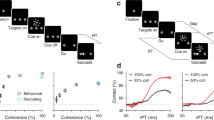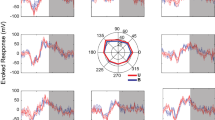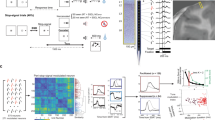Abstract
Natural movements often occur without any immediate external event to cause them. In contrast to reactive movements, which are directly triggered by external cues, it is less clear how these proactive actions are initiated or when they will be made. We found that single neurons in the macaque's lateral intraparietal area (LIP) exhibit gradual firing rate elevations that reach a consistent value—which may correspond to a threshold—at the time of proactive, but not reactive, arm movements. This activity differs from sensory- and motor-related activity recorded in nearby cortical areas and could provide an internal trigger for action when abrupt external triggers in the visual input are unavailable.
This is a preview of subscription content, access via your institution
Access options
Subscribe to this journal
Receive 12 print issues and online access
$209.00 per year
only $17.42 per issue
Buy this article
- Purchase on Springer Link
- Instant access to full article PDF
Prices may be subject to local taxes which are calculated during checkout








Similar content being viewed by others
References
Seal, J. & Commenges, D. A quantitative analysis of stimulus- and movement-related responses in the posterior parietal cortex of the monkey. Exp. Brain Res. 58, 144–153 (1985).
Hanes, D.P. & Schall, J.D. Neural control of voluntary movement initiation. Science 274, 427–430 (1996).
DiCarlo, J.J. & Maunsell, J.H. Using neuronal latency to determine sensory-motor processing pathways in reaction time tasks. J. Neurophysiol. 93, 2974–2986 (2005).
Cook, E.P. & Maunsell, J.H. Dynamics of neuronal responses in macaque MT and VIP during motion detection. Nat. Neurosci. 5, 985–994 (2002).
Gibson, J.J. The Ecological Approach to Visual Perception (Lawrence Erlbaum Associates, Hillsdale, New Jersey, 1979).
Gallistel, C.R. The Organization of Learning (eds. Gleitman, L., Carey, S., Newport, E. & Spelke, E.) (MIT Press, Cambridge, Massachusetts, 1990).
Glimcher, P.W. Decisions, Uncertainty, and the Brain (MIT Press, Cambridge, Massachusetts, 2003).
Romo, R. & Schultz, W. Role of primate basal ganglia and frontal cortex in the internal generation of movements. III. Neuronal activity in the supplementary motor area. Exp. Brain Res. 91, 396–407 (1992).
Deecke, L. Planning, preparation, execution, and imagery of volitional action. Brain Res. Cogn. Brain Res. 3, 59–64 (1996).
Lee, I.H. & Assad, J.A. Putaminal activity for simple reactions or self-timed movements. J. Neurophysiol. 89, 2528–2537 (2003).
Roitman, J.D. & Shadlen, M.N. Response of neurons in the lateral intraparietal area during a combined visual discrimination reaction time task. J. Neurosci. 22, 9475–9489 (2002).
Colby, C.L., Duhamel, J.R. & Goldberg, M.E. Visual, presaccadic, and cognitive activation of single neurons in monkey lateral intraparietal area. J. Neurophysiol. 76, 2841–2852 (1996).
Janssen, P. & Shadlen, M.N. A representation of the hazard rate of elapsed time in macaque area LIP. Nat. Neurosci. 8, 234–241 (2005).
Eskandar, E.N. & Assad, J.A. Distinct nature of directional signals among parietal cortical areas during visual guidance. J. Neurophysiol. 88, 1777–1790 (2002).
Lee, D.N., Georgopoulos, A.P., Clark, M.J., Craig, C.M. & Port, N.L. Guiding contact by coupling the taus of gaps. Exp. Brain Res. 139, 151–159 (2001).
Snyder, L.H., Batista, A.P. & Andersen, R.A. Coding of intention in the posterior parietal cortex. Nature 386, 167–170 (1997).
Bisley, J.W. & Goldberg, M.E. Neuronal activity in the lateral intraparietal area and spatial attention. Science 299, 81–86 (2003).
Mazurek, M.E., Roitman, J.D., Ditterich, J. & Shadlen, M.N. A role for neural integrators in perceptual decision making. Cereb. Cortex 13, 1257–1269 (2003).
Land, M.F. & Lee, D.N. Where we look when we steer. Nature 369, 742–744 (1994).
Land, M.F. & McLeod, P. From eye movements to actions: how batsmen hit the ball. Nat. Neurosci. 3, 1340–1345 (2000).
Land, M., Mennie, N. & Rusted, J. The roles of vision and eye movements in the control of activities of daily living. Perception 28, 1311–1328 (1999).
Johansson, R.S., Westling, G., Backstrom, A. & Flanagan, J.R. Eye-hand coordination in object manipulation. J. Neurosci. 21, 6917–6932 (2001).
Batista, A.P., Buneo, C.A., Snyder, L.H. & Andersen, R.A. Reach plans in eye-centered coordinates. Science 285, 257–260 (1999).
Buneo, C.A., Jarvis, M.R., Batista, A.P. & Andersen, R.A. Direct visuomotor transformations for reaching. Nature 416, 632–636 (2002).
Blatt, G.J., Andersen, R.A. & Stoner, G.R. Visual receptive field organization and cortico-cortical connections of the lateral intraparietal area (area LIP) in the macaque. J. Comp. Neurol. 299, 421–445 (1990).
Lewis, J.W. & Van Essen, D.C. Corticocortical connections of visual, sensorimotor, and multimodal processing areas in the parietal lobe of the macaque monkey. J. Comp. Neurol. 428, 112–137 (2000).
Nakamura, H. et al. From three-dimensional space vision to prehensile hand movements: the lateral intraparietal area links the area V3A and the anterior intraparietal area in macaques. J. Neurosci. 21, 8174–8187 (2001).
Meck, W.H. Neuropsychology of timing and time perception. Brain Cogn. 58, 1–8 (2005).
Onoe, H. et al. Cortical networks recruited for time perception: a monkey positron emission tomography (PET) study. Neuroimage 13, 37–45 (2001).
Brody, C.D., Hernandez, A., Zainos, A. & Romo, R. Timing and neural encoding of somatosensory parametric working memory in macaque prefrontal cortex. Cereb. Cortex 13, 1196–1207 (2003).
Riehle, A. Preparation for action: one of the key functions of the motor cortex. in Motor Cortex in Voluntary Movements: a Distributed System for Distributed Functions (eds. Riehle, A. & Vaadia, E.) 213–240 (CRC Press, Boca Raton, Florida, 2005).
Lewis, J.W. & Van Essen, D.C. Mapping of architectonic subdivisions in the macaque monkey, with emphasis on parieto-occipital cortex. J. Comp. Neurol. 428, 79–111 (2000).
Matelli, M., Govoni, P., Galletti, C., Kutz, D.F. & Luppino, G. Superior area 6 afferents from the superior parietal lobule in the macaque monkey. J. Comp. Neurol. 402, 327–352 (1998).
Scherberger, H. et al. Magnetic resonance image-guided implantation of chronic recording electrodes in the macaque intraparietal sulcus. J. Neurosci. Methods 130, 1–8 (2003).
Barash, S., Bracewell, R.M., Fogassi, L., Gnadt, J.W. & Andersen, R.A. Saccade-related activity in the lateral intraparietal area. I. Temporal properties; comparison with area 7a. J. Neurophysiol. 66, 1095–1108 (1991).
Barash, S., Bracewell, R.M., Fogassi, L., Gnadt, J.W. & Andersen, R.A. Saccade-related activity in the lateral intraparietal area. II. Spatial properties. J. Neurophysiol. 66, 1109–1124 (1991).
Acknowledgements
We thank R. Maimon, T. Herrington, A. Fanini, D. Freedman, C. Padoa-Schioppa and A. Hoffius for comments on the manuscript. K. Irwin, T. LaFratta, M. LaFratta, J. LeBlanc and D. Averbuch provided technical assistance. This work was supported by grant EY12106 from the National Eye Institute, the McKnight Endowment Fund for Neuroscience, and by a predoctoral National Science Foundation fellowship to G.M.
Author information
Authors and Affiliations
Corresponding author
Ethics declarations
Competing interests
The authors declare no competing financial interests.
Rights and permissions
About this article
Cite this article
Maimon, G., Assad, J. A cognitive signal for the proactive timing of action in macaque LIP. Nat Neurosci 9, 948–955 (2006). https://doi.org/10.1038/nn1716
Received:
Accepted:
Published:
Issue Date:
DOI: https://doi.org/10.1038/nn1716
This article is cited by
-
Superior colliculus bidirectionally modulates choice activity in frontal cortex
Nature Communications (2023)
-
Activity map of a cortico-cerebellar loop underlying motor planning
Nature Neuroscience (2023)
-
A rise-to-threshold process for a relative-value decision
Nature (2023)
-
Neural basis of anticipation and premature impulsive action in the frontal cortex
Nature Neuroscience (2022)
-
Thalamus-driven functional populations in frontal cortex support decision-making
Nature Neuroscience (2022)



